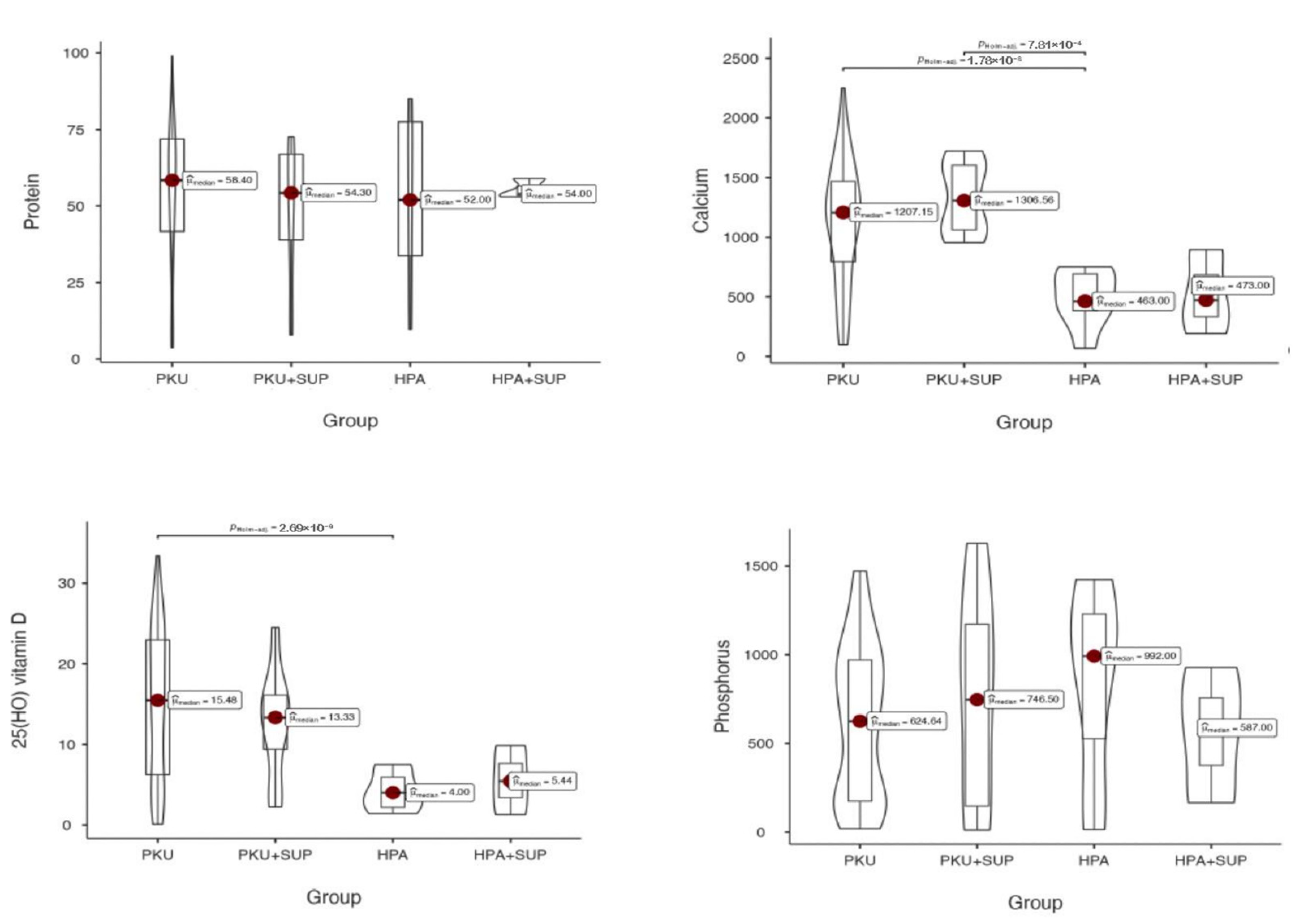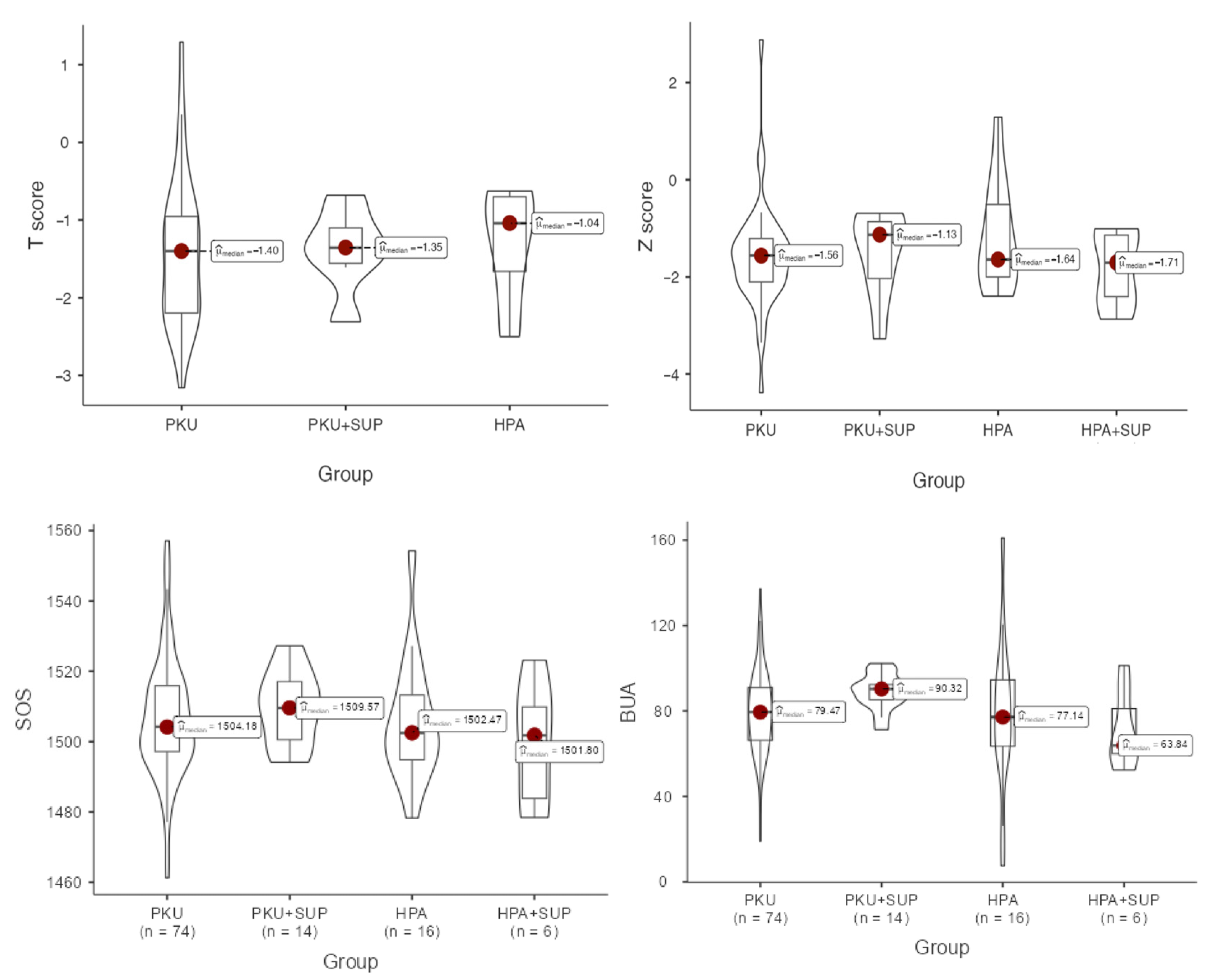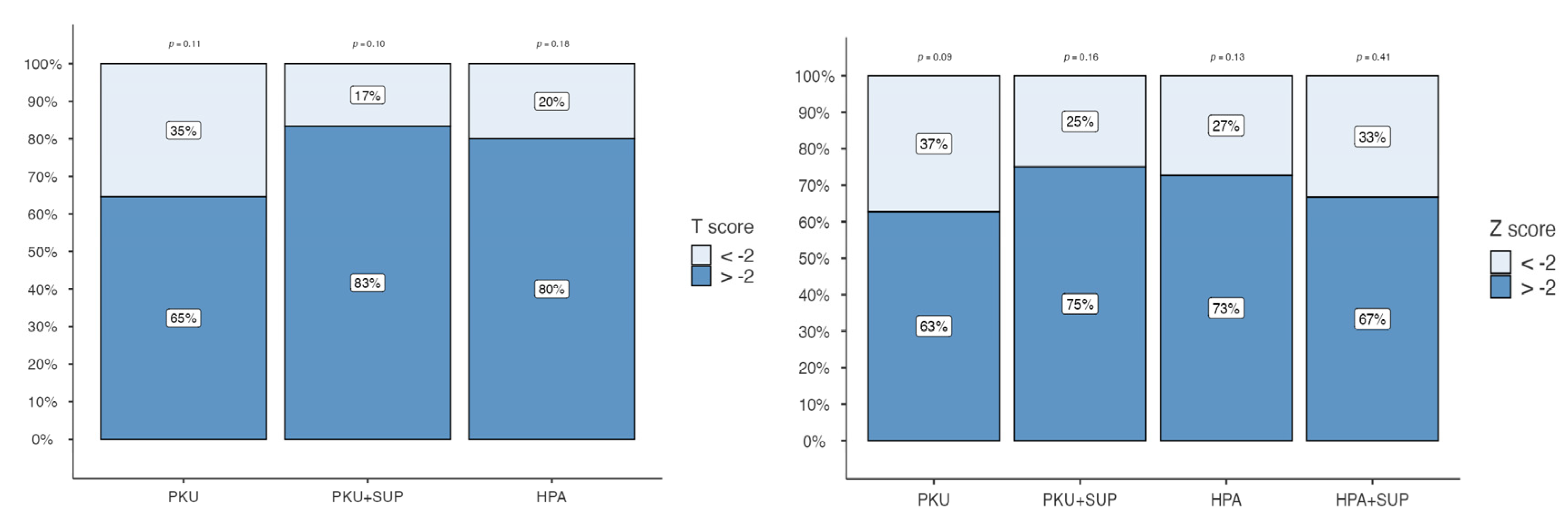Quantitative Ultrasound for the Assessment of Bone Quality in Hyperphenylalaninemia/Phenylketonuria Patients: Vitamin D Supplementation Versus No Supplementation
Abstract
1. Introduction
2. Materials and Methods
2.1. Patients
2.2. Measurements
2.3. Laboratory Data
2.4. Nutritional Assessment
2.5. Statistical Methods
3. Results
4. Discussion
5. Conclusions
Author Contributions
Funding
Institutional Review Board Statement
Informed Consent Statement
Data Availability Statement
Conflicts of Interest
Abbreviations
| HPA | Hyperphenylalaninemia |
| PKU | Phenylketonuria |
| QUS | Quantitative Ultrasound |
| BQI | Bone Quality Index |
| BUA | Broadband Ultrasound Attenuation |
| Phe | Phenylalanine |
| Tyr | Tyrosine |
| PAH | Phenylalanine Hydroxylase |
| BMD | Bone Mineral Density |
| AA | Amino Acids |
| ISCD | International Society of Clinical Densitometry |
| BMI | Body Mass Index |
| SDS | Standard Deviation Score |
| SOS | Speed of Sound |
| HPLC | High-performance Liquid Chromatography |
| IQR | Interquartile Range |
| GMP | Glycomacropeptide |
| CGMP | Casein Glycomacropeptide |
References
- Kylies, J.; Brunne, B.; Rune, G.M. A culture model for the assessment of phenylalanine neurotoxicity in phenylketonuria. In Vitro Models 2022, 1, 103–114. [Google Scholar] [CrossRef] [PubMed] [PubMed Central]
- van Spronsen, F.J.; Blau, N.; Harding, C.; Burlina, A.; Longo, N.; Bosch, A.M. Phenylketonuria. Nat. Rev. Dis. Primers 2021, 7, 36. [Google Scholar] [CrossRef] [PubMed] [PubMed Central]
- de Castro, M.J.; de Lamas, C.; Sánchez-Pintos, P.; González-Lamuño, D.; Couce, M.L. Bone Status in Patients with Phenylketonuria: A Systematic Review. Nutrients 2020, 12, 2154. [Google Scholar] [CrossRef] [PubMed] [PubMed Central]
- Rocha, J.C.; Hermida, Á.; Jones, C.J.; Wu, Y.; Clague, G.E.; Rose, S.; Whitehall, K.B.; Ahring, K.K.; Pessoa, A.L.S.; Harding, C.O.; et al. Meta-analysis of bone mineral density in adults with phenylketonuria. Orphanet J. Rare Dis. 2024, 19, 338. [Google Scholar] [CrossRef] [PubMed] [PubMed Central]
- Demirdas, S.; Coakley, K.E.; Bisschop, P.H.; Hollak, C.E.; Bosch, A.M.; Singh, R.H. Bone health in phenylketonuria: A systematic review and meta-analysis. Orphanet J. Rare Dis. 2015, 10, 17. [Google Scholar] [CrossRef] [PubMed] [PubMed Central]
- Allen, J.R.; Humphries, I.R.; Waters, D.L.; Roberts, D.C.; Lipson, A.H.; Howman-Giles, R.G.; Gaskin, K.J. Decreased bone mineral density in children with phenylketonuria. Am. J. Clin. Nutr. 1994, 59, 419–422. [Google Scholar] [CrossRef] [PubMed]
- Baim, S.; Leonard, M.B.; Bianchi, M.L.; Hans, D.B.; Kalkwarf, H.J.; Langman, C.B.; Rauch, F. Official Positions of the International Society for Clinical Densitometry and executive summary of the 2007 ISCD Pediatric Position Development Conference. J. Clin. Densitom. 2008, 11, 6–21. [Google Scholar] [CrossRef] [PubMed]
- Venegas, E.; Langeveld, S.; Ahring, K.; Benitez, R.; Desloovere, A.; Dios, E.; Gomez, E.; Hermida, A.; Marsaux, C.; Verloo, P.; et al. Nutrient Status and Intakes of Adults with Phenylketonuria. Nutrients 2024, 16, 2724. [Google Scholar] [CrossRef]
- van Wegberg, A.M.J.; MacDonald, A.; Ahring, K.; Bélanger-Quintana, A.; Beblo, S.; Blau, N.; Bosch, A.M.; Burlina, A.; Campistol, J.; Coşkun, T.; et al. European guidelines on diagnosis and treatment of phenylketonuria: First revision. Mol. Genet. Metab. 2025, 145, 109125. [Google Scholar] [CrossRef] [PubMed]
- Tummolo, A.; Carella, R.; De Giovanni, D.; Di Tullio, V.; Lorusso, L.; Bartolomeo, N. A Cross-Sectional Study on Protein Substitutes for Paediatric Phenylketonuria Diet: Time to Pay Attention. Nutrients 2025, 17, 1767. [Google Scholar] [CrossRef] [PubMed] [PubMed Central]
- Stroup, B.M.; Sawin, E.A.; Murali, S.G.; Binkley, N.; Hansen, K.E.; Ney, D.M. Amino Acid Medical Foods Provide a High Dietary Acid Load and Increase Urinary Excretion of Renal Net Acid, Calcium, and Magnesium Compared with Glycomacropeptide Medical Foods in Phenylketonuria. J. Nutr. Metab. 2017, 2017, 1909101. [Google Scholar] [CrossRef] [PubMed] [PubMed Central]
- Hanusch, B.; Schlegtendal, A.; Lücke, T.; Sinningen, K. Ex Vivo Osteoclastogenesis from Peripheral Blood Mononuclear Cells Is Unchanged in Adults with Phenylketonuria, Regardless of Dietary Compliance. Int. J. Mol. Sci. 2025, 26, 5776. [Google Scholar] [CrossRef] [PubMed] [PubMed Central]
- Tummolo, A.; Brunetti, G.; Giordano, M.; Carbone, V.; Faienza, M.F.; Aricò, M.; Pesce, S. The use of quantitative ultrasound in a tertiary-level children hospital: Role in the follow-up of chronically ill patients. J. Ultrasound 2022, 25, 563–570. [Google Scholar] [CrossRef] [PubMed] [PubMed Central]
- Salera, S.; Coacci, S.; Cipriani, A.; Gentilucci, M.; Pierattini, V. Special low protein foods in the management of Inborn Errors of Metabolism: Overview on availability, composition and comparison with regular foods in Italy. JIM 2024, 1, e532. [Google Scholar]
- Robert, M.; Rocha, J.C.; van Rijn, M.; Ahring, K.; Bélanger-Quintana, A.; MacDonald, A.; Dokoupil, K.; Gokmen Ozel, H.; Lammardo, A.M.; Goyens, P.; et al. Micronutrient status in phenylketonuria. Mol. Genet. Metab. 2013, 110, S6–S17. [Google Scholar] [CrossRef] [PubMed]
- Kose, E.; Arslan, N. Vitamin/mineral and micronutrient status in patients with classical phenylketonuria. Clin. Nutr. 2019, 38, 197–203. [Google Scholar] [CrossRef] [PubMed]
- Hanusch, B.; Falkenstein, M.; Volkenstein, S.; Dazert, S.; Lücke, T.; Sinningen, K. No Impairment in Bone Turnover or Executive Functions in Well-Treated Preschoolers with Phenylketonuria-A Pilot Study. Nutrients 2024, 16, 2072. [Google Scholar] [CrossRef] [PubMed] [PubMed Central]
- Hanusch, B.; Schlegtendal, A.; Grasemann, C.; Lücke, T.; Sinningen, K. Adults with Phenylketonuria have suboptimal bone mineral density apart from vitamin D and calcium sufficiency. Front. Endocrinol. 2025, 16, 1488215. [Google Scholar] [CrossRef] [PubMed] [PubMed Central]
- Daly, A.; Högler, W.; Crabtree, N.; Shaw, N.; Evans, S.; Pinto, A.; Jackson, R.; Ashmore, C.; Rocha, J.C.; Strauss, B.J.; et al. A Three-Year Longitudinal Study Comparing Bone Mass, Density, and Geometry Measured by DXA, pQCT, and Bone Turnover Markers in Children with PKU Taking L-Amino Acid or Glycomacropeptide Protein Substitutes. Nutrients 2021, 13, 2075. [Google Scholar] [CrossRef] [PubMed] [PubMed Central]
- Chiba, K.; Suetoshi, R.; Cretin, D.; Arai, T.; Kawajiri, T.; Okayama, A.; Tsuji, S.; Okazaki, N.; Osaki, M.; Yoh, K. Development of a QUS Device to Evaluate Deterioration of Cortical Bone: Verification by HR-pQCT and Measurements in Healthy Individuals and Dialysis Patients. J. Clin. Densitom. 2021, 24, 94–105. [Google Scholar] [CrossRef]
- Hans, D.; Baim, S. Quantitative Ultrasound (QUS) in the Management of Osteoporosis and Assessment of Fracture Risk. J. Clin. Densitom. 2017, 20, 322–333. [Google Scholar] [CrossRef]
- Krieg, M.A.; Barkmann, R.; Gonnelli, S.; Stewart, A.; Bauer, D.C.; Del Rio Barquero, L.; Kaufman, J.J.; Lorenc, R.; Miller, P.D.; Olszynski, W.P.; et al. Quantitative ultrasound in the management of osteoporosis: The 2007 ISCD Official Positions. J. Clin. Densitom. 2008, 11, 163–187. [Google Scholar] [CrossRef] [PubMed]
- Hartman, C.; Shamir, R.; Eshach-Adiv, O.; Iosilevsky, G.; Brik, R. Assessment of osteoporosis by quantitative ultrasound versus dual energy X-ray absorptiometry in children with chronic rheumatic diseases. J. Rheumatol. 2004, 31, 981–985. [Google Scholar] [PubMed]
- Schalamon, J.; Singer, G.; Schwantzer, G.; Nietosvaara, Y. Quantitative ultrasound assessment in children with fractures. J. Bone Miner. Res. 2004, 19, 1276–1279. [Google Scholar] [CrossRef] [PubMed]
- Tanaka, N.Y.Y.; Turcato, M.F.; Nicoletti, C.F.; Nonino, C.B.; Martins, L.D.; Iannetta, O.; Guerreiro, C.T.; Santos, G.G.; Marchini, J.S. Effects of Short-Term Calcium Supplementation in Children and Adolescents with Phenylketonuria. J. Clin. Densitom. 2018, 21, 48–53. [Google Scholar] [CrossRef] [PubMed]
- Porta, F.; Mussa, A.; Zanin, A.; Greggio, N.A.; Burlina, A.; Spada, M. Impact of metabolic control on bone quality in phenylketonuria and mild hyperphenylalaninemia. J. Pediatr. Gastroenterol. Nutr. 2011, 52, 345–350. [Google Scholar] [CrossRef] [PubMed]
- de Groot, M.J.; Hoeksma, M.; van Rijn, M.; Slart, R.H.; van Spronsen, F.J. Relationships between lumbar bone mineral density and biochemical parameters in phenylketonuria patients. Mol. Genet. Metab. 2012, 105, 566–570. [Google Scholar] [CrossRef]
- Adami, S.; Romagnoli, E.; Carnevale, V.; Scillitani, A.; Giusti, A.; Rossini, M.; Gatti, D.; Nuti, R.; Minisola, S. Italian Society for Osteoporosis, Mineral Metabolism and Bone Diseases (SIOMMMS). Linee guida su prevenzione e trattamento dell’ipovitaminosi D con colecalciferolo. SIOMMMS [Guidelines on prevention and treatment of vitamin D deficiency. Italian Society for Osteoporosis, Mineral Metabolism and Bone Diseases (SIOMMMS)]. Reumatismo 2011, 63, 129–147. (In Italian) [Google Scholar] [CrossRef] [PubMed]
- Tummolo, A.; Carella, R.; Paterno, G.; Bartolomeo, N.; Giotta, M.; Dicintio, A.; De Giovanni, D.; Fischetto, R. Body Composition in Adolescent PKU Patients: Beyond Fat Mass. Children 2022, 9, 1353. [Google Scholar] [CrossRef] [PubMed] [PubMed Central]
- Manuals and User Guides for OsteoSys SONOST 3000, version 3.03.06; OsteoSys Co., Ltd.: Seoul, Republic of Korea. Available onlne: https://www.manualslib.com/manual/1285276/Osteosys-Sonost-3000.html (accessed on 10 November 2025).
- Ahmadzadeh, M.; Sohrab, G.; Alaei, M.; Eini-Zinab, H.; Mohammadpour-Ahranjani, B.; Rastgoo, S.; Namkhah, Z. Growth and Nutritional Status of Phenylketonuric Children and Adolescents. BMC Pediatr. 2022, 22, 664. [Google Scholar] [CrossRef] [PubMed] [PubMed Central]
- Matthews, J.J.; Arentson-Lantz, E.J.; Moughan, P.J.; Wolfe, R.R.; Ferrando, A.A.; Church, D.D. Understanding Dietary Protein Quality: Digestible indispensable Amino Acid Scores and Beyond. J. Nutr. 2025, 155, 3152–3167. [Google Scholar] [CrossRef]
- Reis, D.; Schwermer, M.; Nowak, L.; Naami, N.; Zuzak, T.J.; Längler, A. Vegetarian Diet and Dietary Intake, Health, and Nutritional Status in Infants, Children, and Adolescents: A Systematic Review. Nutrients 2025, 17, 2183. [Google Scholar] [CrossRef] [PubMed]
- Dobrowolski, S.F.; Tourkova, I.L.; Sudano, C.R.; Larrouture, Q.C.; Blair, H.C. A New View of Bone Loss in Phenylketonuria. Organogenesis 2021, 17, 50–55. [Google Scholar] [CrossRef] [PubMed] [PubMed Central]
- Dobrowolski, S.F.; Sudano, C.; Phua, Y.L.; Tourkova, I.L.; Spridik, K.; Goetzman, E.S.; Vockley, J.; Blair, H.C. Mesenchymal stem cell energy deficit and oxidative stress contribute to osteopenia in the Pahenu2 classical PKU mouse. Mol. Genet. Metab. 2021, 132, 173–179. [Google Scholar] [CrossRef] [PubMed] [PubMed Central]
- Bokayeva, K.; Jamka, M.; Walkowiak, D.; Duś-Żuchowska, M.; Herzig, K.H.; Walkowiak, J. Vitamin Status in Patients with Phenylketonuria: A Systematic Review and Meta-Analysis. Int. J. Mol. Sci. 2024, 25, 5065. [Google Scholar] [CrossRef] [PubMed] [PubMed Central]
- Wang, F.; Zheng, L.; Theopold, J.; Schleifenbaum, S.; Heyde, C.E.; Osterhoff, G. Methods for bone quality assessment in human bone tissue: A systematic review. J. Orthop. Surg. Res. 2022, 17, 174. [Google Scholar] [CrossRef] [PubMed] [PubMed Central]
- Bauer, D.C.; Glüer, C.C.; Cauley, J.A.; Vogt, T.M.; Ensrud, K.E.; Genant, H.K.; Black, D.M. Broadband ultrasound attenuation predicts fractures strongly and independently of densitometry in older women. A prospective study. Study of Osteoporotic Fractures Research Group. Arch. Intern. Med. 1997, 157, 629–634. [Google Scholar] [CrossRef] [PubMed]
- Roux, C.; Fournier, B.; Laugier, P.; Chappard, C.; Kolta, S.; Dougados, M.; Berger, G. Broadband ultrasound attenuation imaging: A new imaging method in osteoporosis. J. Bone Miner. Res. 1996, 11, 1112–1118. [Google Scholar] [CrossRef]
- Perrott, S.L.; Martin, K.; Keevil, V.L.; Wareham, N.J.; Khaw, K.T.; Myint, P.K. Calcaneal broadband ultrasound attenuation predicts physical capability: EPIC-Norfolk prospective population-based study. Maturitas 2023, 173, 7–15. [Google Scholar] [CrossRef] [PubMed]
- Çıkı, K.; Kahraman, A.B.; Akar, H.T.; Yıldız, Y.; Dursun, A.; Tokatlı, A.; Coşkun, T.; Sivri, S. High prevalence of low bone mineral density in young adults with phenylketonuria. Postgrad. Med. 2025, 137, 86–92. [Google Scholar] [CrossRef] [PubMed]
- Dybal, E.; Maillot, F.; Feillet, F.; Fouilhoux, A.; Astudillo, L.; Lavigne, C.; Arnoux, J.B.; Odent, S.; Gay, C.; Schiff, M.; et al. Bone mineral density in French adults with early-treated phenylketonuria. Mol. Genet. Metab. 2025, 144, 109044. [Google Scholar] [CrossRef] [PubMed]
- Paterno, G.; Di Tullio, V.; Carella, R.; De Ruvo, G.; Furioso, F.; Skublewska-D’Elia, A.; De Giovanni, D.; Tummolo, A. Growth Parameters and Prevalence of Obesity in PKU Patients and Peers: Is This the Right Comparison? Pediatr. Rep. 2024, 16, 892–901. [Google Scholar] [CrossRef] [PubMed] [PubMed Central]
- Lowe, T.B.; DeLuca, J.; Arnold, G.L. Similarities and differences in key diagnosis, treatment, and management approaches for PAH deficiency in the United States and Europe. Orphanet J. Rare Dis. 2020, 15, 266. [Google Scholar] [CrossRef] [PubMed] [PubMed Central]



| Variable | OVERALL | PKU | PKU + SUP | HPA | HPA + SUP | p-Value |
|---|---|---|---|---|---|---|
| (n = 110) | (n = 74) | (n = 14) | (n = 16) | (n = 6) | ||
| Age (yr), median (IQR) | 16.0 (9.0–24.0) | 16.0 (9.0–24.0) | 17.0 (13.5–23.5) | 9.5 (7.5–19.2) | 11.0 (7.0–14.3) | 0.116 a |
| Age, n (%) | 0.204 b | |||||
| <18 yr | 69 (62.7) | 43 (58.1) | 8 (57.1) | 11 (68.7) | 6 (100.0) | |
| ≥18 yr | 44 (37.3) | 31(41.9) | 6 (42.9) | 5 (31.2) | - | |
| Gender, n (%) | 0.326 b | |||||
| Female | 68 (61.8) | 42 (56.7) | 9 (64.3) | 13 (81.2) | 4 (66.7) | |
| Male | 45 (38.2) | 32 (43.3) | 5 (35.7) | 3 (18.8) | 2 (33.3) | |
| BMI (kg/m2), median (IQR) | 21.5 (18.5–24.5) | 21.9 (19.2–25.0) | 21.9 (19.3–25.3) | 21.1 (15.5–22.7) | 15.8 (14.5–23.2) | 0.086 a |
| Variable | PKU | PKU + SUP | HPA | HPA + SUP | Mann–Whitney U Test p-Value |
|---|---|---|---|---|---|
| PE tot (gr) | 46.7 (29.4–59.9) | 43.0 (41.3–60.6) | 0.762 | ||
| Calcium (mg) tot | 1026.4 (695.4–1196.0) | 1080.5 (803.7–1227.0) | 0.569 | ||
| Phosphorus (mg) tot | 672.5 (469.5–828.7) | 747.6 (625.0–954.8) | 0.366 | ||
| Vitamin D (mcg) tot | 18.5 (12.0–23.7) | 15.9 (13.3–20.2) | 0.891 | ||
| gr natural protein | 13.8 (10.3–18.6) | 10.6 (9.38–21.8) | 74.0 (49–83.00) | 54.0 (53.5–56.5) | <0.001 |
| Calcium (mg) | 221 (153–337) | 267 (148–365) | 674 (445–699) | 473 (333–684) | 0.002 |
| Phosphorus (mg) | 245 (181–357) | 283 (176–374) | 1144 (925–1358) | 927 (757–996) | <0.001 |
| Vitamin D (mcg) | 0.1 (0.07–0.19) | 0.07 (0.04–0.16) | 7.5 (5.77–10.4) | 5.44 (3.36–7.65) | <0.001 |
| Variable | PKU | PKU + SUP | HPA | HPA + SUP | Kruskall–Wallis Test p-Value |
|---|---|---|---|---|---|
| Calcium (9–10.8 mg/dL) | 9.90 (9.50–10.10) | 9.50 (9.22–9.67) | 9.70 (9.30- 10.10) | 9.95 (9.72–10.12) | 0.176 |
| Phenilalanine (<120 umol/L) | 452.00 (314.50–764.50) | 474.00 (381.00–600.25) | 202.00 (115.75–242.00) | 193.00 (182.50–203.50) | <0.001 |
| Tyrosine (19–119 umol/L) | 69.36 (54.13–80.83) | 61.63 (58.00–79.37) | 90.17 (55.50–93.54) | 79.25 (68.05–87.35) | 0.576 |
| Total Protein (5.7–8.2 g/dL) | 7.35 (7.00–7.70) | 7.40 (7.20–7.72) | 7.15 (6.97–7.25) | 6.95 (6.90–7.10) | 0.227 |
| Phe/Tyr ratio (<1.3) | 6.20 (4.09–14.89) | 6.22 (4.21–11.96) | 2.45 (1.63–3.15) | 2.57 (2.48–3.48) | <0.001 |
| 25(OH)Vitamin D (30–100 ng/mL) | 27.5 (22.0–38.0) | 23.0 (20.5–41.3) | 27.1 (20.5–31.5) | 26.5 (25.0–27.3) | 0.845 |
| Variable | PKU | PKU + SUP | HPA | HPA + SUP | Kruskall–Wallis Test p-Value |
|---|---|---|---|---|---|
| BQI | 70.6 (60.4–81.2) | 78.6 (71.1–87.5) | 71.6 (57.6–87.3) | 62.1 (47.5–79.2) | 0.212 |
| SOS | 1504 (1497–1516) | 1510 (1501–1517) | 1502 (1495–1513) | 1502 (1484–1510) | 0.580 |
| BUA | 79.5 (66.2–90.8) | 90.3 (85.2–92.4) | 77.1 (63.6–94.6) | 63.8 (60.8–81.1) | 0.040 |
| Z-SCORE | −1.47 (−2.22; −1.04) | −1.35 (−1.55; −1.10) | −0.82 (−1.20; −0.58) | n.d. | 0.577 |
| T-SCORE | −1.55 (−2.08; −1.17) | −1.13 (−2.03; −0.86) | −1.65 (−2.10; −0.71) | −1.71 (−2.41; −1.14) | 0.889 |
Disclaimer/Publisher’s Note: The statements, opinions and data contained in all publications are solely those of the individual author(s) and contributor(s) and not of MDPI and/or the editor(s). MDPI and/or the editor(s) disclaim responsibility for any injury to people or property resulting from any ideas, methods, instructions or products referred to in the content. |
© 2025 by the authors. Licensee MDPI, Basel, Switzerland. This article is an open access article distributed under the terms and conditions of the Creative Commons Attribution (CC BY) license (https://creativecommons.org/licenses/by/4.0/).
Share and Cite
Tummolo, A.; De Ruvo, G.; Di Nicola, M.; Di Tullio, V.; Melpignano, L.; De Giovanni, D.; Carella, R. Quantitative Ultrasound for the Assessment of Bone Quality in Hyperphenylalaninemia/Phenylketonuria Patients: Vitamin D Supplementation Versus No Supplementation. Metabolites 2025, 15, 754. https://doi.org/10.3390/metabo15110754
Tummolo A, De Ruvo G, Di Nicola M, Di Tullio V, Melpignano L, De Giovanni D, Carella R. Quantitative Ultrasound for the Assessment of Bone Quality in Hyperphenylalaninemia/Phenylketonuria Patients: Vitamin D Supplementation Versus No Supplementation. Metabolites. 2025; 15(11):754. https://doi.org/10.3390/metabo15110754
Chicago/Turabian StyleTummolo, Albina, Giada De Ruvo, Marta Di Nicola, Vito Di Tullio, Livio Melpignano, Donatella De Giovanni, and Rosa Carella. 2025. "Quantitative Ultrasound for the Assessment of Bone Quality in Hyperphenylalaninemia/Phenylketonuria Patients: Vitamin D Supplementation Versus No Supplementation" Metabolites 15, no. 11: 754. https://doi.org/10.3390/metabo15110754
APA StyleTummolo, A., De Ruvo, G., Di Nicola, M., Di Tullio, V., Melpignano, L., De Giovanni, D., & Carella, R. (2025). Quantitative Ultrasound for the Assessment of Bone Quality in Hyperphenylalaninemia/Phenylketonuria Patients: Vitamin D Supplementation Versus No Supplementation. Metabolites, 15(11), 754. https://doi.org/10.3390/metabo15110754








